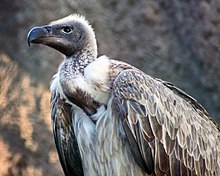Hooded Vulture
| Hooded Vulture | |
|---|---|
 | |
| Conservation status | |
| Scientific classification | |
| Kingdom: | Animalia |
| Phylum: | Chordata |
| Class: | Aves |
| Order: | Accipitriformes |
| Family: | Accipitridae |
| Genus: | Necrosyrtes Gloger, 1841 |
| Species: | N. monachus |
| Binomial name | |
| Necrosyrtes monachus (Temminck, 1823) | |
The Hooded Vulture (Necrosyrtes monachus) is an Old World vulture in the order Accipitriformes, which also includes eagles, kites, buzzards and hawks. It is the only member of the genusNecrosyrtes.
It breeds in a stick nest in trees (often palms) in much of Africa south of the Sahara, laying one egg. Birds may form loose colonies. The population is mostly resident. This is of the smaller vultures of the Old World. They are 62–72 cm (25–28 in) long, have a wingspan of 155–165 cm (61–65 in) and a body weight of 1.5-2.6 kg (3.3-5.7 lbs).
Like other vultures it is a scavenger, feeding mostly from carcasses of dead animals and waste which it finds by soaring over savannah and around human habitation, including waste tips and abattoirs. It often moves in flocks, and is very abundant. In much of its range, there are always several visible soaring in the sky at almost any time during the day.
This vulture is typically unafraid of humans, and frequently gathers around habitation. It is sometimes referred to as the “garbage collector” by locals.
The Hooded Vulture is a typical vulture, with a bald pink head and a greyish “hood”. It has fairly uniform dark brown body plumage. It has broad wings for soaring and short tail feathers. It is a small species compared to most vultures.
If these birds are disturbed when at their nest, they utter a squealing cry of "MAMA MAMA".Formerly classified as Least Concern by the IUCN′ it was found to have been rarer than previously believed and thus its status was uplisted to Endangered on the 2011 Red List of Threatened species.














